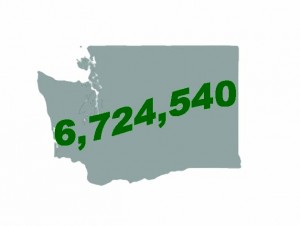What a difference a decade makes …
 Washington’s population has grown by leaps and bounds during the past 10 years — by over 14 percent, to a new nose-count of 6,724,540. The growth: over 830,000 people.
Washington’s population has grown by leaps and bounds during the past 10 years — by over 14 percent, to a new nose-count of 6,724,540. The growth: over 830,000 people.
But that growth, of course, hasn’t been uniform all around the Evergreen State, and so our current legislative and congressional districts are out of whack, population-wise. One of the main purposes of the U.S. Census is to allow us to redistrict every decade so that districts meet the legal requirements for population equality.
Our citizen Redistricting Commission will do that task during the rest of this year. The four voting members — two Rs and two Ds — have been chosen and they have collectively appointed a non-voting chairwoman as the fifth commissioner. The panel has until the end of the year to agree on the boundaries of 10 congressional districts (including the brand new district we received after the 2010 Census) and 49 legislative districts.
The commission has just put out charts that show how much change would be required for each legislative and congressional district to meet a standard of mathematical population equality.
All congressional districts gained population, but some more than others — from 49,000 in the 7th District to nearly 156,000 in the 8th — a difference of more than 100,000 people!
The greatest gains were in the 8th, which is now 138,300 or 20.6 percent above the ideal size, the 3rd (106,894 too many) and the 4th (101,955 over the target number of 672,454). The 7th, 6th and 9th were at the other end of the spectrum with slower growth.
The bottom line, once the new 10th district is allotted its 672,454 population, is that all of our congressional districts have to “lose” some of their people.
The legislative chart is equally interesting, showing how growth has occurred so differently from place to place. One district actually lost people during the decade. The 28th in the Tacoma area lost 754 and needs to grow by 12.9 percent, or 17,742 people to be the ideal size. The nearby 2nd Legislative District, meanwhile, grew like wildfire and now needs to shed 26,471, or more than 19 percent! In all 28 of the 49 districts need to grow population-wise and the rest will need to shed some of theirs.
The new boundaries will take effect next year. Local jurisdictions will also be redrawing various district boundaries as well.